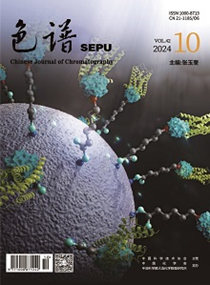[超高效液相色谱-串联质谱法同时测定化妆品中的 83 种糖皮质激素]。
摘要
糖皮质激素是由肾上腺皮质分泌的一类类固醇激素,具有显著的抗炎、免疫抑制和抗过敏作用。因此,这类化合物被广泛应用于临床。然而,长期使用含有糖皮质激素的化妆品会导致严重后果,如激素依赖性皮炎、高血压和其他严重伤害。化妆品安全技术规范》(2015 年版)和欧洲议会及理事会关于化妆品的第 1223/2009 号法规(EC)将糖皮质激素列为禁用原料。据国家医药产品管理局称,近年来有关生产商在化妆品中非法添加糖皮质激素的报告有所增加。因此,建立高通量筛选方法以确保化妆品的质量和安全势在必行。本研究建立了一种基于超高效液相色谱-串联质谱(UPLC-MS/MS)的综合分析方法,用于快速筛查化妆品中的 83 种糖皮质激素。利用化妆品中常用的三种基质:水、乳液和霜(油/水型)对一系列条件进行了优化。然后对四种流动相系统和三种色谱柱进行了优化,以达到最佳分离效果。同时还优化了各种质谱参数,如毛细管电压、锥体电压、脱溶剂气体流速和目标化合物离子对的碰撞能量。此外,由于化妆品复杂的基质效应,前处理对糖皮质激素的测定至关重要。将分析物分为两组,以 lg Kow=4 为限,比较萃取溶剂对回收率的影响。比较了乙腈萃取、丙酮萃取、乙酸乙酯萃取、在饱和氯化钠溶液中分散后用乙腈萃取、在饱和氯化钠溶液中分散后用丙酮萃取、在饱和氯化钠溶液中分散后用乙酸乙酯萃取六种萃取方法对目标分析物的回收率。还比较了 QuEChERS 和固相萃取(SPE)纯化的回收率。根据实验结果,最终的样品前处理方法包括乙腈涡旋分散、超声波萃取和过滤后上样。83 种目标化合物经 Thermo Accucore PFP 色谱柱(100 mm×2.1 mm, 2.6 μm)分离,流动相为 0.1%(体积分数)乙酸乙腈水溶液和 0.1%(体积分数)乙酸水溶液。分析物在电喷雾正离子模式(ESI+)下通过动态多重反应监测(MRM)测定,并采用外标法定量。使用基质标准曲线以减少基质效应。83 种目标化合物的定标曲线在 2-200 μg/L 质量浓度范围内线性关系良好(r>0.995)。在三个添加水平下,回收率为 74.5%-112.4%,相对标准偏差(RSD,n=6)为 0.8%-9.9%。方法的检出限(LOD,信噪比≥3)为0.001~0.023 μg/g,定量限(LOQ,信噪比≥10)为0.002~0.076 μg/g。所建立的方法用于41种化妆品样品中糖皮质激素的检测。在 4 个样品中检测到了醋酸氟西诺龙、二丙酸倍氯米松、21-醋酸地索奈德和地索奈德。阳性样品中糖皮质激素的含量范围为 0.53-634.27 微克/克。值得注意的是,在两批样品中检测到了不在法定检测方法范围内的 21-乙酸去甲内酯。总之,该方法简便、灵敏、可靠,适用于不同基质化妆品中 83 种糖皮质激素的高通量分析。该方法可为化妆品的日常监管提供可靠的技术支持,并可作为现行糖皮质激素标准的补充。
![[Simultaneous determination of 83 glucocorticoids in cosmetics by ultra performance liquid chromatography-tandem mass spectrometry].](https://img.booksci.cn/booksciimg/2023-12/2025081878230438744806653245845.jpg)
![[Simultaneous determination of 83 glucocorticoids in cosmetics by ultra performance liquid chromatography-tandem mass spectrometry].](https://img.booksci.cn/booksciimg/2023-12/2025081878258486721752804058142.jpg)
![[Simultaneous determination of 83 glucocorticoids in cosmetics by ultra performance liquid chromatography-tandem mass spectrometry].](https://img.booksci.cn/booksciimg/2023-12/2025081878299903788947778793929.jpg)
Glucocorticoids, which are a class of steroidal hormones secreted by the adrenal cortex, have significant anti-inflammatory, immunosuppressive, and anti-allergic effects. Thus, these compounds are widely used in clinical practice. However, the long-term use of cosmetics containing glucocorticoids can lead to serious consequences, such as hormone-dependent dermatitis, hypertension, and other serious injuries. The Safety and Technical Specification for Cosmetics (2015 edition) and Regulation (EC) No. 1223/2009 of the European Parliament and Council on cosmetic products list glucocorticoids as prohibited raw materials. According to the National Medical Products Administration, reports on the illegal addition of glucocorticoids to cosmetics by manufacturers have increased in recent years. Therefore, establishing high-throughput screening methods to ensure the quality and safety of cosmetics is imperative. In this study, a comprehensive analytical method based on ultra performance liquid chromatography-tandem mass spectrometry (UPLC-MS/MS) was developed for the rapid screening of 83 glucocorticoids in cosmetics. A series of conditions were optimized using three matrices that are commonly used in cosmetics: water, lotion, and cream (o/w-type). Four mobile-phase systems and three chromatographic columns were then optimized to achieve the best separation effects. Various MS parameters, such as the capillary voltages, cone voltages, desolvation gas flow rates, and collision energies of the ion pairs of the target compounds, were also optimized. Furthermore, pretreatment was essential for glucocorticoid determination owing to the complex matrix effects of cosmetics. The analytes were divided into two groups, with lg Kow=4 as the limit, to compare the effects of the extraction solvent on recoveries. The extraction recoveries of target analytes with six extraction methods, namely, extraction with acetonitrile, extraction with acetone, extraction with ethyl acetate, dispersion in saturated sodium chloride solution followed by extraction with acetonitrile, dispersion in saturated sodium chloride solution followed by extraction with acetone, and dispersion in saturated sodium chloride solution followed by extraction with ethyl acetate, were compared. The recoveries from QuEChERS and solid-phase extraction (SPE) purification were also compared. Based on the experimental results, the final sample pretreatment method included acetonitrile vortex dispersion, ultrasonic extraction, and sample loading after filtration. The 83 target compounds were separated on a Thermo Accucore PFP column (100 mm×2.1 mm, 2.6 μm) with 0.1% (v/v) acetic acid in acetonitrile and 0.1% (v/v) acetic acid in water as the mobile phases. The analytes were determined by dynamic multiple-reaction monitoring (MRM) in electrospray positive ionization mode (ESI+) and quantified using the external standard method. Matrix standard curves were used to reduce matrix effects. The calibration curves of the 83 target compounds were linear in the mass concentration range of 2-200 μg/L (r>0.995). At three levels of addition, the recoveries were 74.5%-112.4%, and the relative standard deviations (RSDs, n=6) were 0.8%-9.9%. The limits of detection (LODs, S/N≥3) were 0.001-0.023 μg/g, and the limits of quantification (LOQs, S/N≥10) were 0.002-0.076 μg/g. The developed method was used to detect glucocorticoids in 41 cosmetic samples. Fluocinolone acetonide, beclomethasone dipropionate, desonide 21-acetate, and desonide were detected in four samples. The content range of glucocorticoids in the positive samples was 0.53-634.27 μg/g. Notably, desonide 21-acetate, which is not included in the scope of the statutory detection method, was detected in two batches of samples. In conclusion, the proposed method is simple, sensitive, reliable, and suitable for the high-throughput analysis of the 83 glucocorticoids in cosmetics with different matrices. This method could provide reliable technical support for the daily supervision of cosmetics and serve as a supplement to current glucocorticoid standards.

 求助内容:
求助内容: 应助结果提醒方式:
应助结果提醒方式:


